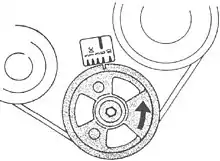Pinch point hazard
A pinch point or pinch point hazard is a common class of mechanical hazard where injury or damage may be done by one or more objects moving towards each other, crushing or shearing whatever comes between them.[1] A nip point is a type of pinch point involving rotating objects, such as gears and pulleys.[2] Injuries can range from minor such as blisters to severe like amputations and fatalities.[3] Examples of pinch point hazards include gaps in closing doors and objects swinging or being lowered near fixed objects.[4]

Common causes of injuries
Safety controls

Pre-work hazard inspections can be performed to identify pinch point hazards. These hazards can be managed with control methods, listed below according to the hazard control hierarchy.[1]
Engineering controls physically prevent objects from entering the pinch point.
- Barriers and machine guards[1]
Administrative controls inform worker behavior to avoid pinch points.
- Area demarcation [1]
- Lockout–tagout[1]
- Situational awareness[1]
- Use of appropriate training,[2] work procedures, instructions, and operating manuals[1]
Personal protective equipment protects individuals exposed to the hazard by preventing objects from being pinched.[1]
See also
- Hazard – Situation or object that can cause damage
- Mechanical hazard- Hazard with a mechanical energy source
- Occupational hazard – Hazard experienced in the workplace
- Physical hazard – Hazard due to a physical agent
References
- "Causes and controls for preventing pinch point injuries". Industrial Safety and Hygiene News. 9 February 2018. Retrieved 8 August 2020.
- "Woodworking eTool | Machine Hazards > Nip Points". www.osha.gov. Retrieved 2020-10-22.
- Environmental Health and Safety. "WVU Pinch Point Hazards" (PDF). West Virginia University. Retrieved 15 October 2020.
- Middle Georgia State University. "Pinch Points: Safety Training" (PDF). Retrieved 3 October 2020.